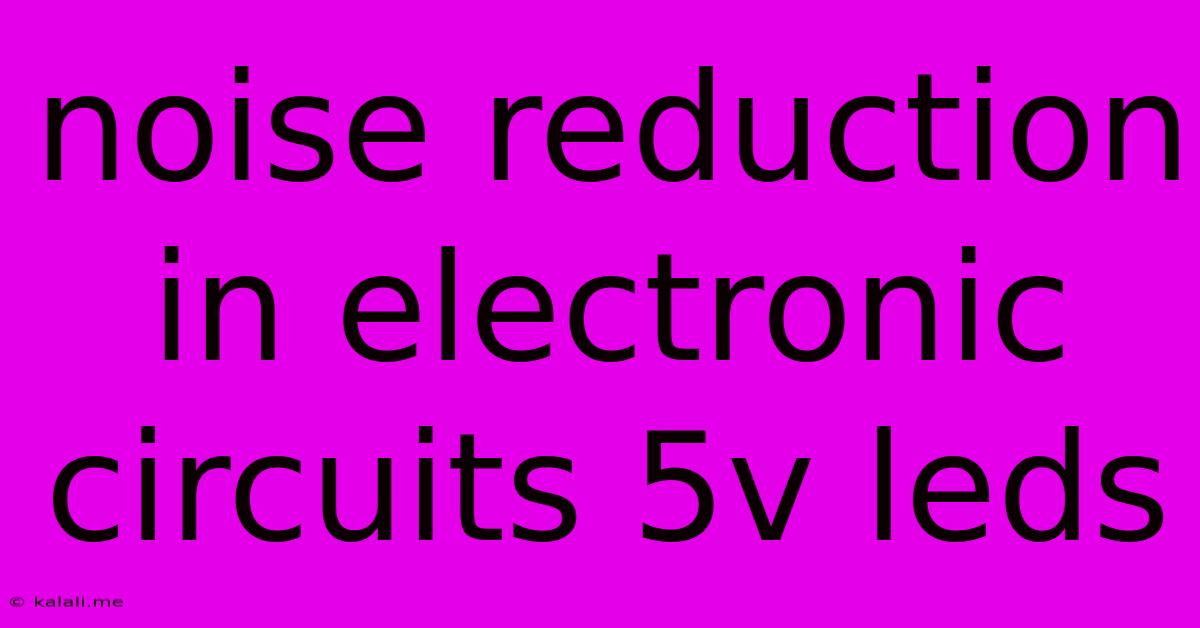Noise Reduction In Electronic Circuits 5v Leds
Kalali
May 23, 2025 · 3 min read

Table of Contents
Noise Reduction in Electronic Circuits with 5V LEDs
Meta Description: Learn effective techniques for minimizing noise in electronic circuits, specifically focusing on 5V LED applications. This guide covers common noise sources, filtering methods, and practical solutions to enhance circuit performance and LED brightness stability.
Noise in electronic circuits can significantly impact the performance of components, especially light-emitting diodes (LEDs). For 5V LED applications, even subtle noise can lead to flickering, inconsistent brightness, and reduced lifespan. This article explores the common sources of noise in such circuits and offers practical solutions for effective noise reduction.
Understanding Noise Sources in 5V LED Circuits
Several factors can introduce noise into a circuit powering 5V LEDs. Identifying these sources is the first step towards effective mitigation.
-
Power Supply Noise: The most common culprit is a noisy power supply. Ripple voltage, switching noise from switching regulators, and inadequate filtering can all contribute to unwanted fluctuations in the voltage supplied to the LEDs. Cheap or poorly designed power supplies are particularly prone to this issue.
-
Grounding Issues: Poor grounding practices create voltage fluctuations, manifesting as noise. Ground loops, high impedance ground paths, and inadequate grounding points can introduce significant noise into the circuit.
-
Electromagnetic Interference (EMI): External electromagnetic fields from nearby devices (motors, radios, etc.) can induce noise into the circuit, affecting the LED's operation. This is especially problematic in environments with high levels of electromagnetic activity.
-
Switching Transistors: If using transistors to control the LEDs, switching transients can inject noise into the circuit. Fast switching speeds exacerbate this issue.
-
Capacitive Coupling: Stray capacitance between circuit components can couple noise from one part of the circuit to another, affecting the LED's current and brightness.
Effective Noise Reduction Techniques for 5V LEDs
Several techniques can effectively minimize noise in 5V LED circuits. The optimal approach depends on the specific noise sources and the circuit's design.
-
Power Supply Filtering: Implementing a robust power supply filtering stage is crucial. This typically involves using capacitors – a combination of bulk capacitors (large capacitance, low ESR) and smaller ceramic capacitors (high frequency filtering) – to smooth out voltage ripples and attenuate high-frequency noise.
-
Grounding Improvement: Ensure a clean, low-impedance ground plane. Use wide, low-resistance traces for ground connections, avoid long ground loops, and utilize a star grounding technique to minimize potential differences between different parts of the circuit.
-
EMI Shielding: If EMI is a significant concern, consider shielding sensitive parts of the circuit using conductive enclosures or metal cans. This effectively reduces the impact of external electromagnetic fields.
-
Proper Component Selection: Choose components with low noise characteristics. For transistors, opt for low-noise types with minimal switching transients. Using high-quality LEDs with consistent forward voltage characteristics can also reduce variations in brightness caused by noise.
-
Current Limiting: Proper current limiting is crucial to prevent LED damage and ensure consistent brightness. Resistors, current regulators, or constant current LED drivers offer excellent control over the LED current, minimizing variations caused by noise.
Practical Implementation and Considerations
Applying these techniques often involves a combination of approaches. For instance, improving the power supply filtering while simultaneously optimizing grounding can significantly reduce noise. Remember to choose components appropriate for the current and voltage levels involved. In high-power LED applications, the heat dissipation and thermal management of the LED and surrounding components are crucial to prevent performance degradation.
Implementing noise reduction measures might require some experimentation to find the optimal solution for your specific application. Careful observation and testing with an oscilloscope are essential in identifying noise sources and verifying the effectiveness of your mitigation strategies. Remember to always prioritize safety when working with electronic circuits and LEDs.
By understanding the sources of noise and implementing the appropriate reduction techniques, you can significantly improve the performance and reliability of your 5V LED circuits, achieving stable, consistent, and long-lasting illumination.
Latest Posts
Latest Posts
-
How To Get A Comb Out Of Your Hair
May 23, 2025
-
1 4 Cup Uncooked Rice To Cooked
May 23, 2025
-
What Is Your Relationship With The Patient
May 23, 2025
-
Deposit Check Made Out To Business In Personal Account
May 23, 2025
-
How To Heat Up A Chicken Pot Pie
May 23, 2025
Related Post
Thank you for visiting our website which covers about Noise Reduction In Electronic Circuits 5v Leds . We hope the information provided has been useful to you. Feel free to contact us if you have any questions or need further assistance. See you next time and don't miss to bookmark.